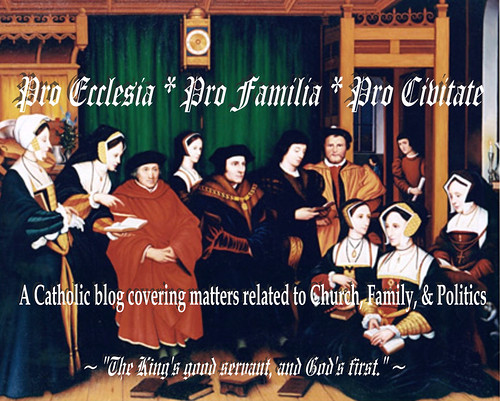St. Brigid of Kildare - 1 February
Recta Ratio has a nice post on St. Brigid of Kildare.
And the Medieval Saints Yahoo Group has this:
St. Brigid of Kildare (Incorrectly known as BRIDGET), virgin, abbess, martyr
Also known as Bride; Bride of the Isles; Brigid of Kildare Brigit; Ffraid; Mary of the Gael
Died 523 at Kildare, Ireland of natural causes; buried in Downpatrick, Ireland with Saint Patrick and Saint Columba; head removed to Jesuit church in Lisbon, Portugal
Commemorated February 1
Patronage: babies, blacksmiths, boatmen, cattle, chicken farmers, children whose parents are not married, dairymaids, dairy workers, fugitives, infants, Ireland (co-patron with St. Patrick), Leinster, Ireland, mariners, midwives, milk maids, newborn babies, nuns, poets, poultry farmers, poultry raisers, printing presses, sailors, scholars, travellers, watermen
In art, she is often shown with a cow lying at her feet; or holding a cross and casting out the devil (White). Her emblem is a lighted lamp or candle (not to be confused with Saint Geneviève, who is not an abbess). At times she may be shown (1) with a flame over her; (2) geese or cow near her; (3) near a barn; (4) letting wax from a taper fall upon her arm; or (5) restoring a man's hand
St. Brigid of Ireland, Feastday: February 1
http://www.catholic.org/saints/saint.php?saint_id=453
Brigid was probably born at Faughart near Dundalk, Louth, Ireland. Her parents were baptized by St. Patrick, with whom she developed a close friendship. According to legend, her father was Dubhthach, an Irish chieftain of Lienster, and her mother, Brocca, was a slave at his court. Even as a young girl she evinced an interest for a religious life and took the veil in her youth from St. Macaille at Croghan and probably was professed by St. Mel of Armagh, who is believed to have conferred abbatial authority on her. She settled with seven of her virgins at the foot of Croghan Hill for a time and about the year 468, followed Mel to Meath. About the year 470 she founded a double monastery at Cill-Dara (Kildare) and was Abbess of the convent, the first in Ireland. The foundation developed into a center of learning and spirituality, and around it grew up the Cathedral city of Kildare. She founded a school of art at Kildare and its illuminated manuscripts became famous, notably the Book of Kildare, which was praised as one of the finest of all illuminated Irish manuscripts before its disappearance three centuries ago. Brigid was one of the most remarkable women of her times, and despite the numerous legendary, extravagant, and even fantastic miracles attributed to her, there is no doubt that her extraordinary spirituality, boundless charity, and compassion for those in distress were real. She died at Kildare on February 1. The Mary of the Gael, she is buried at Downpatrick with St. Columba and St. Patrick, with whom she is the patron of Ireland. Her name is sometimes Bridget and Bride. Her feast day is February 1.
-----------------------
BRIGID of Ireland Profile
http://www.catholic-forum.com/saints/saintb03.htm
Daughter of Dubtach, pagan Scottish king of Leinster, and Brocca, a Christian Pictish slave who had been baptized by Saint Patrick. Just before Brigid's birth, her mother was sold to a Druid landowner. Brigid remained with her mother till she was old enough to serve her legal owner Dubtach, her father.
She grew up marked by her high spirits and tender heart, and as a child, she heard Saint Patrick preach, which she never forgot. She could not bear to see anyone hungry or cold, and to help them, often gave away things that were Dubtach's. When Dubtach protested, she replied that "Christ dwelt in every creature". Dubtach tried to sell her to the King of Leinster, and while they bargained, she gave a treasured sword of her father's to a leper. Dubtach was about to strike her when Brigid explained she had given the sword to God through the leper, because of its great value. The King, a Christian, forbade Dubtach to strike her, saying "Her merit before God is greater than ours". Dubtach solved this domestic problem by giving Brigid her freedom.
Brigid's aged mother was in charge of her master's dairy. Brigid took charge ,and often gave away the produce. But the dairy prospered under her (hence her patronage of milk maids, dairy workers, cattle, etc.), and the Druid freed Brigid's mother.
Brigid returned to her father, who arranged a marriage for her with a young bard. Bride refused, and to keep her virginity, went to Bishop Mel, a pupil of Saint Patrick's, and took her first vows. Legend says that she prayed that her beauty be taken from her so no one would seek her hand in marriage; her prayer was granted, and she regained her beauty only after making her vows. Another tale says that when Saint Patrick heard her final vows, he mistakenly used the form for ordaining priests. When told of it he replied, "So be it, my son, she is destined for great things."
Her first convent started with seven nuns. At the invitation of bishops, she started convents all over Ireland. She was a great traveller, especially considering the conditions of the time, which led to her patronage of travellers, sailors, etc. Brigid invented the double monastery, the monastery of Kildare on the Liffey being for both monks and nuns. Combeth, noted for his skill in metalwork, became its first bishop; this connection and the installation of a bell that lasted over 1000 years apparently led to her patronage of blacksmiths and those in related fields.
---------------------
More on St. Brigit at:
http://www.newadvent.org/cathen/02784b.htm
http://www.catholic-forum.com/saints/stb03002.htm
http://www.cin.org/saints/bridget.html
http://www.stthomasirondequoit.com/SaintsAlive/id625.htm
Labels: Ireland, Saints and Martyrs



0 Comments:
Post a Comment
<< Home